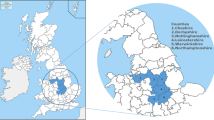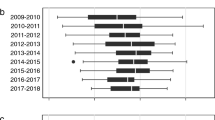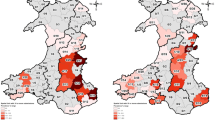Abstract
Pathogens that are transmitted between wildlife, livestock and humans present major challenges for the protection of human and animal health, the economic sustainability of agriculture, and the conservation of wildlife. Mycobacterium bovis, the aetiological agent of bovine tuberculosis (TB), is one such pathogen. The incidence of TB in cattle has increased substantially in parts of Great Britain in the past two decades, adversely affecting the livelihoods of cattle farmers and potentially increasing the risks of human exposure. The control of bovine TB in Great Britain is complicated by the involvement of wildlife, particularly badgers (Meles meles), which appear to sustain endemic infection and can transmit TB to cattle1. Between 1975 and 1997 over 20,000 badgers were culled as part of British TB control policy, generating conflict between conservation and farming interest groups2. Here we present results from a large-scale field trial3,4,5 that indicate that localized badger culling not only fails to control but also seems to increase TB incidence in cattle.
This is a preview of subscription content, access via your institution
Access options
Subscribe to this journal
Receive 51 print issues and online access
$199.00 per year
only $3.90 per issue
Buy this article
- Purchase on Springer Link
- Instant access to full article PDF
Prices may be subject to local taxes which are calculated during checkout



Similar content being viewed by others
References
Krebs, J. et al. Bovine Tuberculosis in Cattle and Badgers PB3423 (MAFF Publications, London, 1997)
Krebs, J. et al. Badgers and bovine TB: Conflicts between conservation and health. Science 279, 817–818 (1998)
Bourne, J. et al. Towards a Sustainable Policy to Control TB in Cattle PB3881 (First Annual Report of the Independent Scientific Group on Cattle TB, MAFF Publications, London, 1998)
Bourne, J. et al. An Epidemiological Investigation into Bovine Tuberculosis PB4870 (Second Annual Report of the Independent Scientific Group on Cattle TB, MAFF Publications, London, 1999)
Bourne, J. et al. An Epidemiological Investigation into Bovine Tuberculosis PB5801 (Third Annual Report of the Independent Scientific Group on Cattle TB, Defra Publications, London, 2001)
Hopkins, F. G. Committee on Cattle Diseases: Report (HMSO, London, 1934)
Hardie, R. M. & Watson, J. M. Mycobacterium bovis in England and Wales: past, present and future. Epidemiol. Infect. 109, 23–33 (1992)
Woodroffe, R., Frost, S. D. W. & Clifton-Hadley, R. Attempts to control tuberculosis in cattle by removing infected badgers: constraints imposed by live test sensitivity. J. Appl. Ecol. 36, 494–501 (1999)
Mollison, D. TB in Cattle: First Report of the Statistical Auditor on the Badger Culling Trial PB5385 (MAFF Publications, London, 2000)
Cresswell, W. Report of the Independent Audit of Surveying and Badger Social Group Territory Delineation Procedures in the Randomised Badger Culling Trial and MAFF's Response PB5497 (MAFF Publications, London, 2001)
Kirkwood, J. K. Report of the Independent Auditor on the Humaneness of the Despatch Procedures Used in the Randomised Badger Culling Trial and MAFF's Response PB5325 (MAFF Publications, London, 2000)
Ewbank, R. Report of the Second Independent Auditor on the Humaneness of Despatch Procedures Used in the Randomised Badger Culling Trial and Defra's Response PB8253 (Defra Publications, London, 2003)
Le Fevre, A. M. et al. Changes in Badger Setts Over the First Three Years of the Randomised Badger Culling Trial 〈http://www.svepm.org.uk/Posters2003/poster_files/LeFevre.pdf〉 (2003).
Roper, T. J. & Lüps, P. Disruption of territorial behaviour in badgers Meles meles. Z. Säugetierkunde 58, 252–255 (1993)
Cheeseman, C. L., Cresswell, W. J., Harris, S. & Mallinson, P. J. Comparison of dispersal and other movements in two badger (Meles meles) populations. Mamm. Rev. 18, 51–59 (1988)
Tuyttens, F. A. M., Macdonald, D. W., Rogers, L. M., Cheeseman, C. L. & Roddam, A. W. Comparative study on the consequences of culling badgers (Meles meles) on biometrics, population dynamics and movement. J. Anim. Ecol. 69, 567–580 (2000)
Rogers, L. M. et al. Movement of badgers (Meles meles) in a high-density population: Individual, population and disease effects. Proc. R. Soc. Lond. B 265, 1269–1276 (1998)
Eves, J. A. Impact of badger removal on bovine tuberculosis in east County Offaly. Ir. Vet. J. 52, 199–203 (1999)
Griffin, J. M. in Selected Papers 1996 6–9 (Tuberculosis Investigation Unit, University College Dublin, 1996)
King, E. J., Lovell, D. J. & Harris, S. in Advances in Vertebrate Pest Management (eds Cowan, D. P. & Feare, C. J.) 147–161 (Filander, Fürth, 1999)
Doncaster, C. P. & Woodroffe, R. Den site can determine shape and size of badger territories: implications for group-living. Oikos 66, 88–93 (1993)
Acknowledgements
This study was funded and implemented by the Department of Environment, Food and Rural Affairs (DEFRA). We acknowledge the contribution made by staff of DEFRA and its associated agencies. We also wish to thank the many farmers and landowners in the trial areas who allowed the experimental treatments to operate on their land. W. T. Johnston helped prepare Fig. 3.Authors' contributions J.B., C.A.D., D.R.C., G.G., J.P.M., W.I.M. and R.W. constitute the Independent Scientific Group on Cattle TB, and were jointly responsible for designing and overseeing the study. Statistical analyses were carried out by D.R.C., C.A.D. and A.M.L.F. C.A.D. and R.W. drafted the manuscript, although all authors contributed to its preparation.
Author information
Authors and Affiliations
Corresponding author
Ethics declarations
Competing interests
The authors declare that they have no competing financial interests.
Rights and permissions
About this article
Cite this article
Donnelly, C., Woodroffe, R., Cox, D. et al. Impact of localized badger culling on tuberculosis incidence in British cattle. Nature 426, 834–837 (2003). https://doi.org/10.1038/nature02192
Received:
Accepted:
Published:
Issue Date:
DOI: https://doi.org/10.1038/nature02192
This article is cited by
-
Impact of test, vaccinate and remove protocol on home ranges and nightly movements of badgers in a medium density population
Scientific Reports (2023)
-
A systemic approach to assess the potential and risks of wildlife culling for infectious disease control
Communications Biology (2020)
-
Isolation of Angola-like Marburg virus from Egyptian rousette bats from West Africa
Nature Communications (2020)
-
Development of a diagnostic compatible BCG vaccine against Bovine tuberculosis
Scientific Reports (2019)
-
Fluorescent biomarkers demonstrate prospects for spreadable vaccines to control disease transmission in wild bats
Nature Ecology & Evolution (2019)
Comments
By submitting a comment you agree to abide by our Terms and Community Guidelines. If you find something abusive or that does not comply with our terms or guidelines please flag it as inappropriate.



